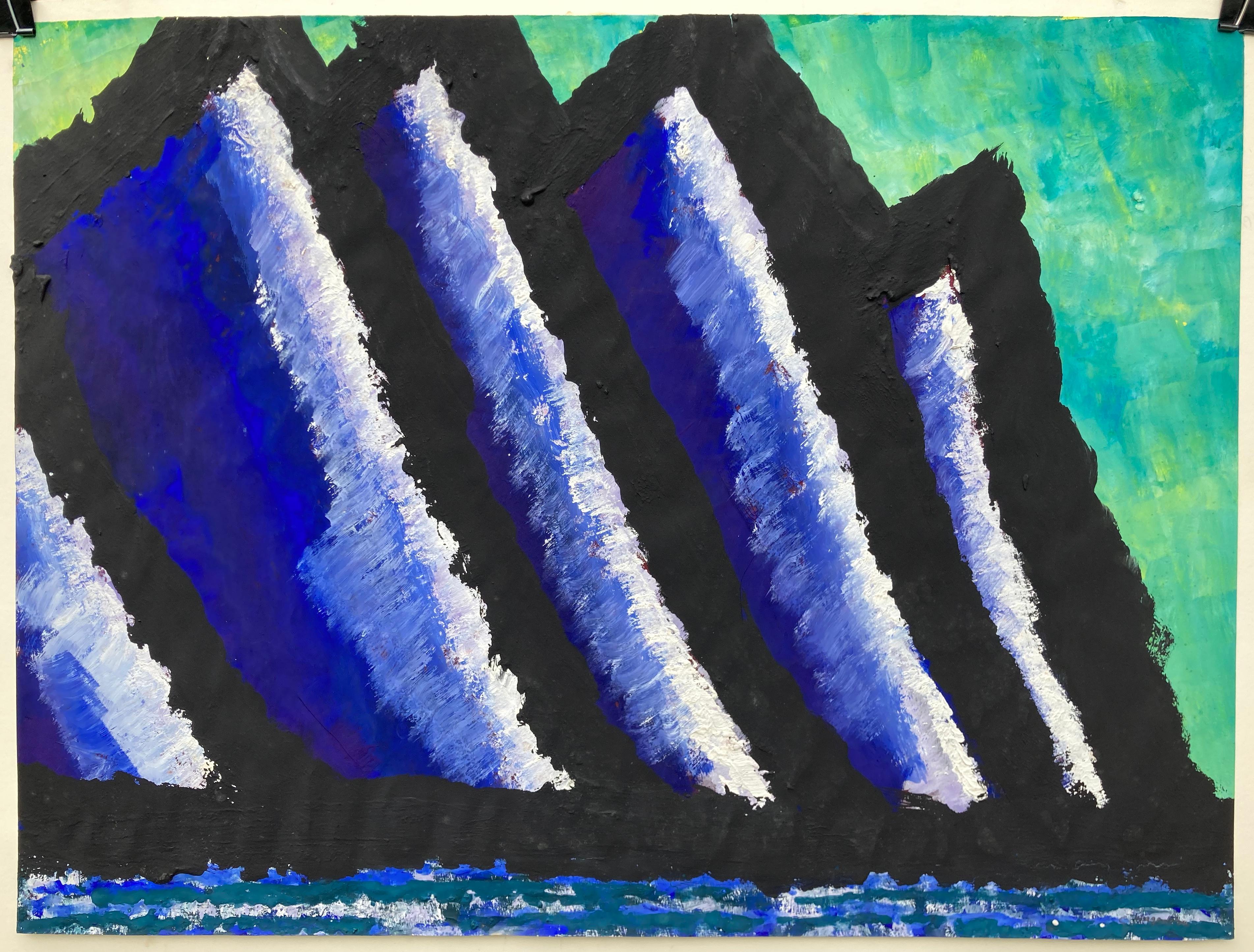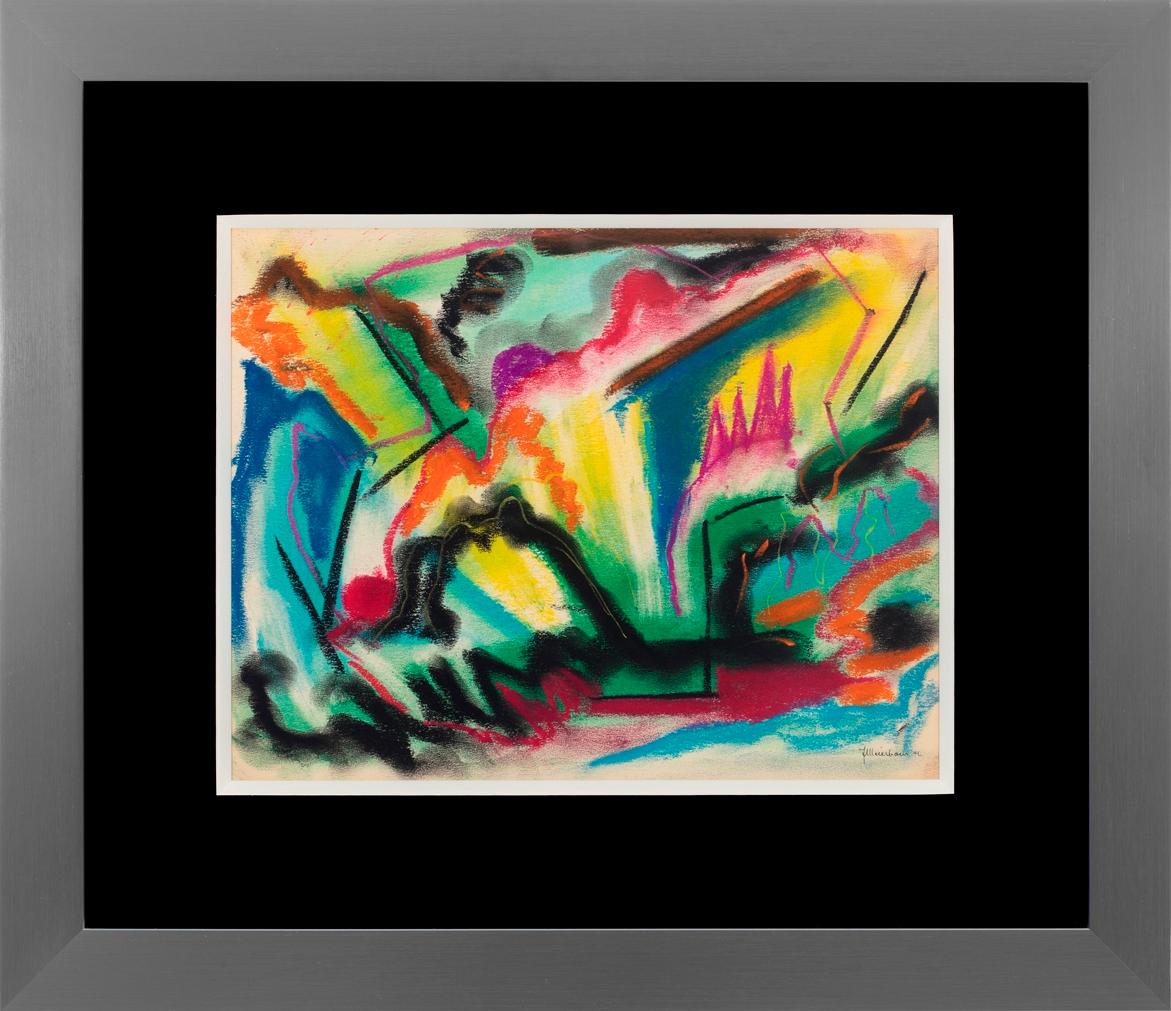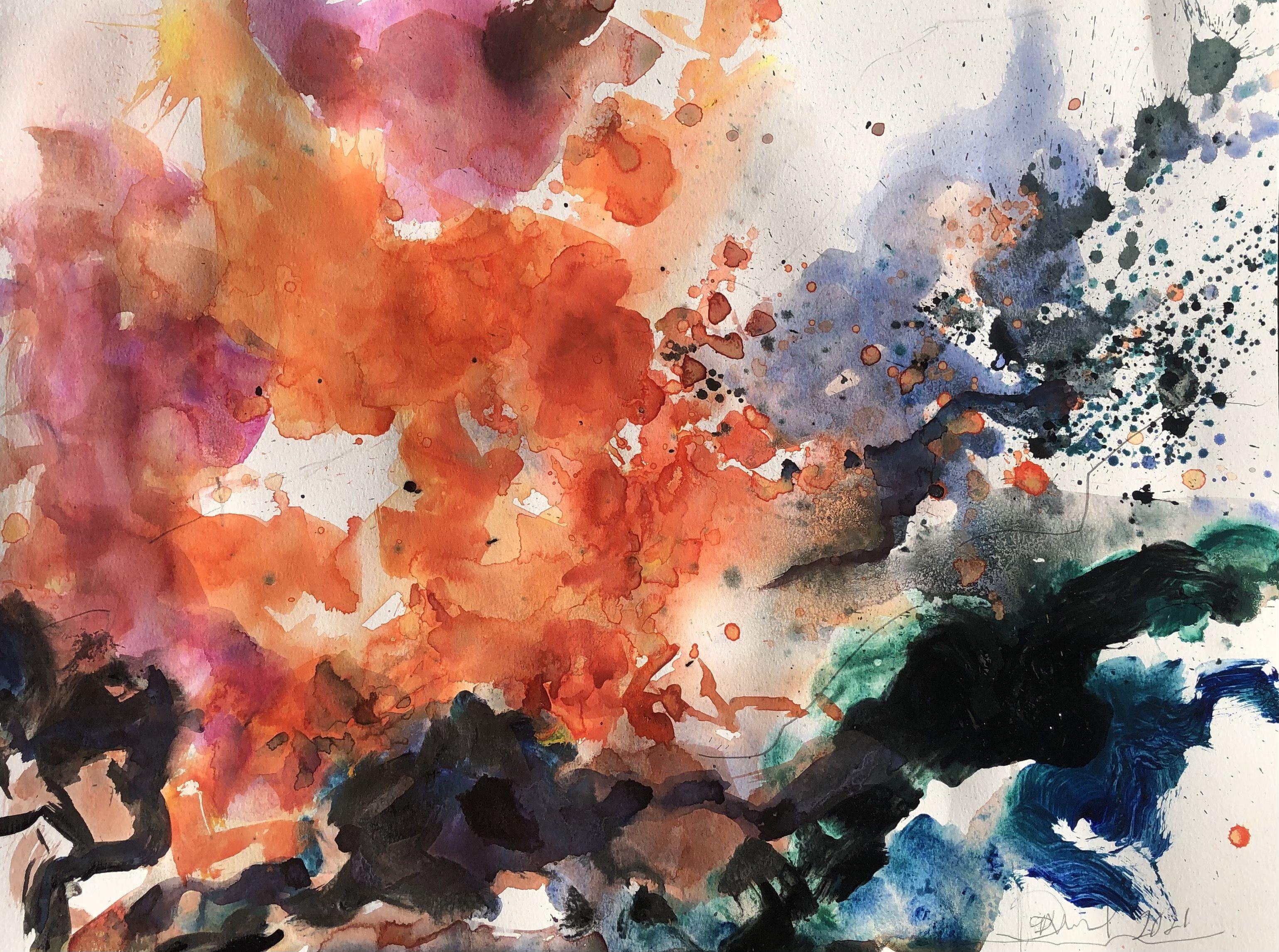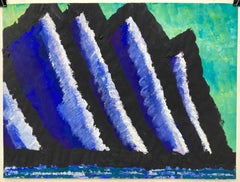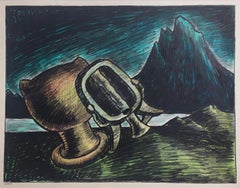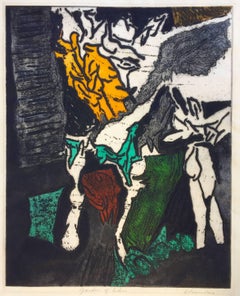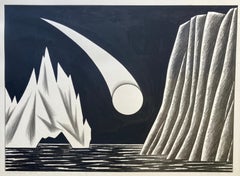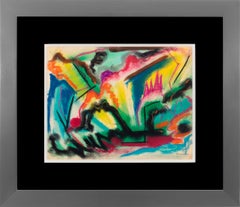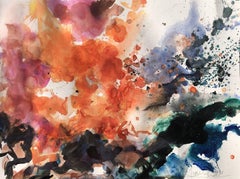Items Similar to VOLCANO
Want more images or videos?
Request additional images or videos from the seller
1 of 8
Edward HagedornVOLCANOca 1935
ca 1935
Price Upon Request
Price Upon Request
Price Upon Request
Price Upon Request
Price Upon Request
Price Upon Request
Price Upon Request
Price Upon Request
Price Upon Request
Price Upon Request
Shipping
Retrieving quote...The 1stDibs Promise:
Authenticity Guarantee,
Money-Back Guarantee,
24-Hour Cancellation
About the Item
EDWARD HAGEDORN (AMERICAN 1902 – 1982)
VOLCANO c. 1935
Thick tempera, SIGNED at the upper right corner,. Sheet & image 18 1/2 x 25 inches.
Provenance: Hagedorn estate, Around the mid 1980's The Hagedorn estate was dispersed in Berkeley by a local dealer. This painting was part of a group of Hagedorn works on paper that I acquired from that dispersal. Much of the balance was later acquired the Struart Denenberg Fine Art.
Denenberg published a very fine book on the artist's work.
EDWARD HAGEDORN: CALIFORNIA MODERNIST, RESTLESSNESS AND RESTRAINT Hardcover – January 1, 2009
Subsequently Hagedorn's works on paper have been acquired by many museums and some accompanying exhibitions.
ALL OF THE COMMENTS BELOW ARE FROM THE FOLLOWING EXHIBITION
EDWARD HAGEDORN (1902-1982)
American Modernist
A New Traveling Exhibition
“VOLCANOS, WRECKS, RIOTS, & NUDES”, EDWARD HAGEDORN (1902-1982)
premiere at the Danforth Museum. Framingham, MA, in March 2016. The exhibition includes 75 works of art in various mediums and is accompanied by the first monograph devoted to the artist’s work with essays by leading curators, critics, and art historians.
Edward Hagedorn was a true Modernist who created a trove of powerful works on paper--drawings, watercolors, oils, and original graphics that reveal the hand of a master draftsman and the mind of an astute political observer. He rejected the general trend in early 20th century California of local landscapes and coastal views, becoming virtually the single voice of Expressionism. He conveyed the darkness and upheaval that gripped the country in the depression years between the two World Wars, 1925- 1935, more forcefully than any of his contemporaries, influenced by German art of the time, engaging in modernist styles of Expressionism and Surrealism.
Hagedorn’s skeletons are ferocious yet somehow endearing; printed in deep black ink on off-white paper, they march across Lilliputian landscapes of grim disorder and destruction. Comets and volcanoes explode in fauvist colors, their other-worldly fluorescent temperas framed in black, while nude female figures, executed in exquisitely refined pen and ink, or graphite line drawings, are as economical in their means as Matisse, and can be compared with the neo-classical drawings of Picasso. Among his most lyrical works of the 1920s is a series of rhythmically abstracted watercolor and ink views of Golden Gate Park, evoking the sensual demi-geometries of Balthus, Derain , and early Mondrian.
American Modernist Edward Hagedorn (1902-1982) was born in San Francisco of German descent; his mother (née Kafka) died in childbirth, and he was legally adopted and raised by his grandmother and aunt. After attendance at the San Francisco School of Fine Arts in the early 1920s, by age 22 he had a studio in the famed "100" block of Montgomery Street ("the Monkey Block,") then a haven for bohemians.
In 1926, a year of tremendous importance in California artists' embrace of modern art, the Oakland Art Gallery, with the guidance and inspiration of their European representative Emmy (Galka) Scheyer, was the first museum in the United States to show the art of the "Blue Four," among the leading artists of International Modernism--Paul Klee, Lyonel Feininger, Alexei Jawlensky, and Wassily Kandinsky.
The overwhelming influences in Scheyer's exhibitions in Oakland and later in Pasadena, were German art movements. She appreciated the abstractionist teaching of Hans Hoffman, who later taught at the University of California, Berkeley, and his Munich students, as well as the increasing importance of Bauhaus, Dada, and Surrealist aesthetics. Hagedorn, of German extraction, was drawn to these influences. Scheyer offered to represent his work, inviting the young artist to become the fifth member of her distinguished group. He rejected her overtures. Scheyer's group of Hagedorn drawings was left to the the Norton Simon Museum, together with her important collection of works by the Blue Four, and major examples by Dix, Kirchner, Kokoschka, Leger, Lissitsky, Nolde, Schwitters, Schlemmer, and Picasso.
"Ed was an outsider, a loner, a tall thin man who walked down the street looking like a question-mark; he had no use for success," according to fellow artist Paul Carey. Financially independent from the 1930's on, having inherited a sizable income from his maternal family's insurance agency, Hagedorn made little effort to market his art, but continued to work prodigiously in the seclusion of his studio/residence in Berkeley, and was active in bohemian North Beach, San Francisco, a friend and illustrator of writer Kenneth Rexroth and poet Czeslaw Milosz.
Oakland Museum Director William Clapp was intellectually open to the entire spectrum of modernism, and in 1927 included Hagedorn's painting of a female nude wearing nothing but silk stockings. It created a scandal reminiscent of the first exhibition of Courbet's 1866 oil, "Origin of the World," or recently Robert Mapplethorpe's explicit photographs. Then critic for The Chronicle, Gene Hailey, together with a "lady's committee" demanded the painting's withdrawal in newspaper articles and in letters to Director Clapp who steadfastly supported freedom of expression. Despite attempts at censorship and disinheritance by his wealthy father, Hagedorn persisted in his convictions, and refused to withdraw the work; he continued to depict the female nude throughout his long life.
Edward Hagedorn achieved critical national acclaim exhibiting widely, and winning print competitions at the De Young Museum, the Brooklyn Museum, and the Pennsylvania Academy of Fine Art, participating as well in the Works Progress Administration (the WPA.) In the 1960s, eminent San Francisco Chronicle critic Alfred Frankenstein stated, "Hagedorn is one of the finest draughtsman I ever knew."
Some public collections holding Hagedorn's work include the Norton Simon Museum; Chicago Art Institute; National Museum of American Art, Achenbach Foundation for Graphic Art, San Francisco; Carnegie Art Institute, the Huntington Museum; Oakland Museum of Art; the National Museum of American Art, Smithsonian Instituion; Library of Congress; Whitney Museum of American Art; Getty Center; and the Fitzwilliam Museum, Cambridge, England.
Edward Hagedorn's art is a major discovery in American Modernism. He conveyed more forcefully than most of his contemporaries the darkness and upheaval that gripped the country in the years between the two World Wars and during the Great Depression. This exhibition reveals the hand of a master draftsman and the mind of an astute political observer who rejected bucolic landscapes.
Hagedorn’s images insist on eidetic registration: skeletons, ferocious yet somehow endearing, printed in dark black ink on off-white paper, marching across Lilliputian landscapes of grim disorder and destruction; comets and volcanoes exploding in other-worldly colors, their fluorescent temperas framed in thick black outline; nude female figures in exquisitely refined pen and ink or graphite line drawings, as economical in their means as Matisse or the neo-classical drawings of Picasso occasionally splashed with watercolor or pastel reminiscent of Schiele. He also created lyrical landscapes, Surrealist experiments, and homages to the female form in a compelling decades-long production of watercolors, pastels, ink, monotypes, etchings, lithographs, and relief prints. This first retrospective of the art of Edward Hagedorn reveals an artist powerfully in command of marks on paper, wryly observant of human folly; he was a gifted draftsman who created indelible images and unforgettable impressions of the most powerful forces of nature.
When Hagedorn died intestate in 1982, the bulk of his life's work was discovered in the Woolsey Street attic in dozens of boxes filled with hundreds of prints, watercolors, temperas, and drawings. Heir-finder attorneys settled a million dollars in cash and securities on a distant relative the artist had never met.
EDWARD HAGEDORN
Selected Quotes
This first retrospective of the art of Edward Hagedorn (American 1902-1982), reveals an artist powerfully in command of marks on paper, wryly observant of human folly, a gifted draftsman creating indelible images and unforgettable impressions of the most powerful forces of nature.
-Robert Flynn Johnson, Curator Emeritus, Achenbach Foundation For Graphic Arts, Fine Arts Museums of San Francisco
“….Hagedorn’s diversity…. can be described on a second level, that of the imaginative wealth of his imagery in the service of a profound, often neurotic, and politically astute content. Based in the violent and repressive politics of the 1930’s and 1940’s, the best of these images engage with European Expressionism without blindly following the style’s tenets, nor succumbing to the ironic detachment of the Neo- Expressionists of the 1980’s. Instead, Hagedorn’s images remain engaged, powerful, even forbidding.… ...Their monumentalizing quality is direct and arresting, and continues to feel surprisingly contemporary.
Dr. James Steward, Director of the Princeton University Museum, former Director of the University Museum, Berkeley--©The Regents of the University of California, courtesy Berkeley Art Museum,1996
“…..a sensibility of great formal inventiveness and fierce, almost unhinged, moral concern. In an era when artists had to assert themselves increasingly to get noticed, particularly on the West Coast, Hagedorn kept to himself. ….nudes in tempera on paper… are rendered with a bold, big-fisted simplicity that suggests a middle path between Alexei Jawlensky and Fernand Léger. “
Kenneth Baker, San Francisco Chronicle, July 10, 1996
"Hagedorn’s mystical landscape visions, closer to the expressionism of Germans such as Oskar Kokoschka and Emil Nolde than to the formalist constructs of Hans Hofmann, had a place in both worlds, the realms of the abstract painter and of the social critic. With a highly personal, idiosyncratic language, he managed to convey the darkness and upheaval that gripped San Francisco in the depression years more forcefully than any of his contemporaries."
Dr. Patricia Junker, Ann M. Barwick Curator of American Art, Seattle Art Museum; former Curator, Amon Carter Museum of Art; former Associate Curator, American Painting, De young Memorial Art Museum, San Francisco, 2009
"That Hagedorn is able to communicate terror and the terrible in the absence of impassioned or hysterical brushwork makes his take on Expressionism unique indeed – that which is most compelling in Hagedorn’s work – the restlessness and the restraint.”
Susan Kandel, Los Angeles Times, March 5, 1992
"The power of Hagedorn’s anti-war series derives from dramatic visual presence often rendered in stark black and white, his skeletons throwing grenades, sounding a trumpet, and sowing dragon’s-seed bayonets which sprout as soldiers. These all-too-human figures have a life of their own, including the revelation of their mortality as stripped flesh; they draw us back to the immediate and fresh experience of the graphic image, and that is where Hagedorn concentrated his powers as an artist."
DIckran Tashjian, Professor Emeritus of Art History, School of Humanities, University of California--Irvine, 2009
“Edward Hagedorn’s images proclaim their importance through their intrinsic graphic power and their bold simplicity. When I first encountered the work several years ago, I found it difficult to believe that such an achievement had, apparently, gone unremarked in studies of California modernist art—the subject of a book I was preparing. So there was, and still is, the excitement of discovery attached to the work of Edward Hagedorn."
Dr. Paul Karlstrom, former West Coast Director, Archives of American Art, Smithsonian Institution, 2009
- Creator:Edward Hagedorn (1902 - 1982, American)
- Creation Year:ca 1935
- Dimensions:Height: 18.5 in (46.99 cm)Width: 25 in (63.5 cm)
- Medium:
- Period:
- Condition:
- Gallery Location:Santa Monica, CA
- Reference Number:1stDibs: LU411312750272
About the Seller
5.0
Recognized Seller
These prestigious sellers are industry leaders and represent the highest echelon for item quality and design.
Gold Seller
Premium sellers maintaining a 4.3+ rating and 24-hour response times
Established in 1977
1stDibs seller since 2016
289 sales on 1stDibs
Typical response time: 1 hour
Associations
International Fine Print Dealers Association
- ShippingRetrieving quote...Shipping from: Santa Monica, CA
- Return Policy
Authenticity Guarantee
In the unlikely event there’s an issue with an item’s authenticity, contact us within 1 year for a full refund. DetailsMoney-Back Guarantee
If your item is not as described, is damaged in transit, or does not arrive, contact us within 7 days for a full refund. Details24-Hour Cancellation
You have a 24-hour grace period in which to reconsider your purchase, with no questions asked.Vetted Professional Sellers
Our world-class sellers must adhere to strict standards for service and quality, maintaining the integrity of our listings.Price-Match Guarantee
If you find that a seller listed the same item for a lower price elsewhere, we’ll match it.Trusted Global Delivery
Our best-in-class carrier network provides specialized shipping options worldwide, including custom delivery.More From This Seller
View AllUNTITLED MOUNTAINS
By Edward Hagedorn
Located in Santa Monica, CA
EDWARD HAGEDORN (AMERICAN 1902 – 1982)
UNTITLED MOUNTAINS, ca 1935
Tempera, Unsigned. Image 18 x 24 inches. See also 1stdibs item LU411312750272 for another example form the follow...
Category
1930s Surrealist Landscape Drawings and Watercolors
Materials
Tempera
Price Upon Request
SURREALIST LANDSCAPE
By Edward Hagedorn
Located in Santa Monica, CA
EDWARD HAGEDORN (AMERICAN 1902 – 1982)
SURREAL LANDSCAPE 1931 mixed media on paper, Graphite, ink and watercolor. Unsigned. Dtaed 2/26/31, in ink lower left margin. Image 13 3/4 x 16 1/2 inches. On a large sheet 20 x 25 inches.
Provenance: Hagedorn estate, Around the mid 1980's The Hagedorn estate was dispersed in Berkeley by a local dealer. This drawing was part of a group of Hagedorn works on paper that I acquired from that dispersal. Much of the balance was later acquired the Struart Denenberg Fine Art.
Denenberg published a very fine book on the artist's work.
EDWARD HAGEDORN: CALIFORNIA MODERNIST, RESTLESSNESS AND RESTRAINT Hardcover – January 1, 2009
Subsequently Hagedorn's works on paper have been acquired by many museums and some accompanying exhibitions.
ALL OF THE COMMENTS BELOW ARE FROM THE FOLLOWING EXHIBITION
EDWARD HAGEDORN (1902-1982)
American Modernist
A New Traveling Exhibition
“VOLCANOS, WRECKS, RIOTS, & NUDES”, EDWARD HAGEDORN (1902-1982)
premiere at the Danforth Museum. Framingham, MA, in March 2016. The exhibition includes 75 works of art in various mediums and is accompanied by the first monograph devoted to the artist’s work with essays by leading curators, critics, and art historians.
Edward Hagedorn was a true Modernist who created a trove of powerful works on paper--drawings, watercolors, oils, and original graphics that reveal the hand of a master draftsman and the mind of an astute political observer. He rejected the general trend in early 20th century California of local landscapes and coastal views, becoming virtually the single voice of Expressionism. He conveyed the darkness and upheaval that gripped the country in the depression years between the two World Wars, 1925- 1935, more forcefully than any of his contemporaries, influenced by German art of the time, engaging in modernist styles of Expressionism and Surrealism.
Hagedorn’s skeletons are ferocious yet somehow endearing; printed in deep black ink on off-white paper, they march across Lilliputian landscapes of grim disorder and destruction. Comets and volcanoes explode in fauvist colors, their other-worldly fluorescent temperas framed in black, while nude female figures, executed in exquisitely refined pen and ink, or graphite line drawings, are as economical in their means as Matisse, and can be compared with the neo-classical drawings of Picasso. Among his most lyrical works of the 1920s is a series of rhythmically abstracted watercolor and ink views of Golden Gate Park, evoking the sensual demi-geometries of Balthus, Derain , and early Mondrian.
American Modernist Edward Hagedorn (1902-1982) was born in San Francisco of German descent; his mother (née Kafka) died in childbirth, and he was legally adopted and raised by his grandmother and aunt. After attendance at the San Francisco School of Fine Arts in the early 1920s, by age 22 he had a studio in the famed "100" block of Montgomery Street ("the Monkey Block,") then a haven for bohemians.
In 1926, a year of tremendous importance in California artists' embrace of modern art, the Oakland Art Gallery, with the guidance and inspiration of their European representative Emmy (Galka) Scheyer, was the first museum in the United States to show the art of the "Blue Four," among the leading artists of International Modernism--Paul Klee, Lyonel Feininger, Alexei Jawlensky...
Category
1930s American Modern Mixed Media
Materials
Watercolor
$3,000 Sale Price
33% Off
Garden of Eden
By Leonard Edmondson
Located in Santa Monica, CA
LEONARD EDMONDSON (1906 – 2001)
GARDEN OF EDEN c. 1960
Color intaglio (carborundum?) Signed and titled in pencil. Small edition, these larger prints...
Category
1960s Abstract Expressionist Abstract Prints
Materials
Intaglio
$960 Sale Price
20% Off
PLUNGING COMET
By Edward Hagedorn
Located in Santa Monica, CA
EDWARD HAGEDORN (AMERICAN 1902 – 1982)
PLUNGING COMET - Large Ink and graphite drawing. Signed, titled and dated in pencil. Image, 16 x 22, Sheet 22 1/2 x 28 1/2 inches
See also ...
Category
1930s Surrealist Landscape Drawings and Watercolors
Materials
Granite
Price Upon Request
MALLORCA
By Dorr Bothwell
Located in Santa Monica, CA
DORR BOTHWELL ( 1902 - 2000)
MALLORCA
Serigraph, Signed, titled and numbered 8/25 in pencil. Signed and dated in the print. Image. 13 1/8 x 9 inches, sheet 19 7/8 x 12 3/4 inches. ...
Category
1950s Abstract Expressionist Abstract Prints
Materials
Screen
DEBRIS - Large Ink Drawing - Study for the Print
By Edward Hagedorn
Located in Santa Monica, CA
EDWARD HAGEDORN (AMERICAN 1902 – 1982)
DEBRIS, ca. 1930 Large Ink Drawing - Study for the Print.
Image 16 1/2 x 22 1/2 inches, sheet 17 1/2 x 28 inches. Ink wash, on blank side of...
Category
1930s Realist Figurative Drawings and Watercolors
Materials
Ink
You May Also Like
"Volcano"
By Joseph Meierhans
Located in Lambertville, NJ
Jim’s of Lambertville is proud to offer this artwork by:
Joseph Meierhans (1890 - 1980)
Joseph Meierhans is one of the most important modernist painters associated with Bucks Coun...
Category
1940s Abstract Expressionist Abstract Drawings and Watercolors
Materials
Pastel
Abstract Watercolor Painting, 'Design for Land', C. 1997 by David Ruth
By David Ruth
Located in Oakland, CA
This is a contemporary abstract watercolor painting by artist David Ruth. This series of paintings often feature bright colors and vibrant layouts that draw the viewer in. They are c...
Category
1990s Abstract Expressionist Abstract Paintings
Materials
Paper, Watercolor
Eruption Kilauea Volcano, Painting, Watercolor on Watercolor Paper
By Daniel Clarke
Located in Yardley, PA
Kilauea volcano on the Big Island roared back to life recently as lava went shooting into air, boiling away a water lake and sending a massive plume of steam, gas and ash soaring int...
Category
2010s Abstract Abstract Drawings and Watercolors
Materials
Watercolor
Volcanic, Large Abstract Painting by Richard Weston
By Richard Weston
Located in Long Island City, NY
Artist: Richard Weston, American XXth
Title: Volcanic
Year: circa 1980
Medium: Acrylic on Canvas, signed l.r.
Size: 48 x 60 in. (121.92 x 152.4 cm)
Category
1980s Abstract Abstract Paintings
Materials
Canvas, Acrylic
Mountainous Landscape
Located in Douglas, Isle of Man
Raymond James Coxon 1896-1997, was an English landscape and portrait painter, he was a war artist during the second World war after which his works became more abstract. He studied a...
Category
Mid-20th Century Landscape Drawings and Watercolors
Materials
Paper, Watercolor
Untitled #2
By Jerry Opper
Located in San Francisco, CA
This artwork "Untitled #2" c.1970 is a colors pastel and crayon on thick paper by American artist Jerry Opper, 1924-2014. It is hand signed with initial in pencil at the lower right corner by the artist. The image size is 23 x 18 inches, sheet size is 24 x 19 inches. It is in excellent condition, there are pastel marks on the margin all around the artwork and also on the back, see picture #1.
About the artist:
Jerry Opper was born in Cleveland, Ohio, on September 5, 1924. He moved to Los Angeles with his family in 1933. After graduating from Hollywood High School, he worked in movie studios and attended art classes at Chouinard Art Institute. In May 1942, Opper was drafted into the army and was then able to study at the Colorado Springs Fine Arts Center while his outfit was stationed in Colorado. Later he was sent to Guam and was discharged in December 1945.
Opper returned to Chouinard and his work in movie studios until 1947, when he moved to San Francisco. He enrolled as a full-time student at the California School of Fine Arts (now SFAI) and received his diploma in June of 1950. In 1948, Opper met his wife Gertrud Ruth Friedmann, daughter of artist Gustav Friedmann, whose works are also in the Lost Art Salon collection. It was love at first sight and a few weeks after their first encounter at the Black Cat in San Francisco's North Beach, they got married and enjoyed a passionate, life-long romance.
Shortly after he finished school, Opper worked briefly as a decorator’s assistant and then started his career as a commercial artist, working for several firms such as Fibreboard, Beatrix Food and Precision. Working full-time and dedicating himself to having a rich family life occupied most of Opper's time, but he continued to be creative. He was above all a family man with the pride of having raised two exceptional daughters, Erika and Jody. Year after year, Opper would painstakingly craft their Halloween costumes...
Category
Late 20th Century American Modern Abstract Drawings and Watercolors
Materials
Pastel
More Ways To Browse
Edward View
Black And White Etchings Drawings
Edward Paul
Volcano Art
Picasso Purple
Nude Line Drawing Female
Volcano Painting
Black And White Drawings Female Nudes
1920s California Landscape Paintings
Embracing Nude Figures
Kenneth Young
Depression Era Paintings
Black And White Two Nude Females
Picasso Nude Etching
Writers Block
Golden Gate Park
Skeleton Human
Monkey Oil Painting
